Although it was hailed as “the ultimate in suspension bridge design” on the day that it opened to traffic, its demise would become known as “the most dramatic failure in bridge engineering history.” A watershed moment in the field of bridge engineering, the collapse of the First Tacoma Narrows Bridge demonstrated that extreme economy of material could be dangerous and that the wind was a force to be reckoned with. And yet, engineers have learned from the mistakes of the past. Eighty years on and bridge engineers are still setting records for suspension bridge spans. In this edition of TheBridgeGuy, we’ll examine the events that led to the collapse and what, if anything, engineers learned from it.
The waterway that we now call the ‘Narrows’ was first charted by Charles Wilkes in 1841 during the United States Exploring Expedition. It is a strait oriented northwest-southeast and separates the Kitsap Peninsula from what is today the City of Tacoma. At about a mile wide, the Narrows is where the Central Basin and Southern Basin of Puget Sound meet. Although not narrow generally speaking, the strait represents a considerable narrowing of the Sound between the two basins. During tidal exchanges, water is forced through the Narrows at surprising speeds. Currents average about 6 knots four times a day, and can even be as high as 12 knots during extreme tide changes.

The Pacific Northwest is known for its windstorms. The most powerful winds occur when an area of low pressure enters the Strait of Juan de Fuca and hovers over the San Juan archipelago. The greater the pressure differential, the more severe the wind – usually from the south. These winds combined with the topography of western Washington often make for some damaging windstorms. During these windstorms, air is forced between the Olympic and Cascade mountain ranges which creates strong gale force winds in the lowlands – in some cases even reaching hurricane force. At the Narrows, the land rises nearly 200 feet on both sides of the strait and this local channeling makes winds even more severe.
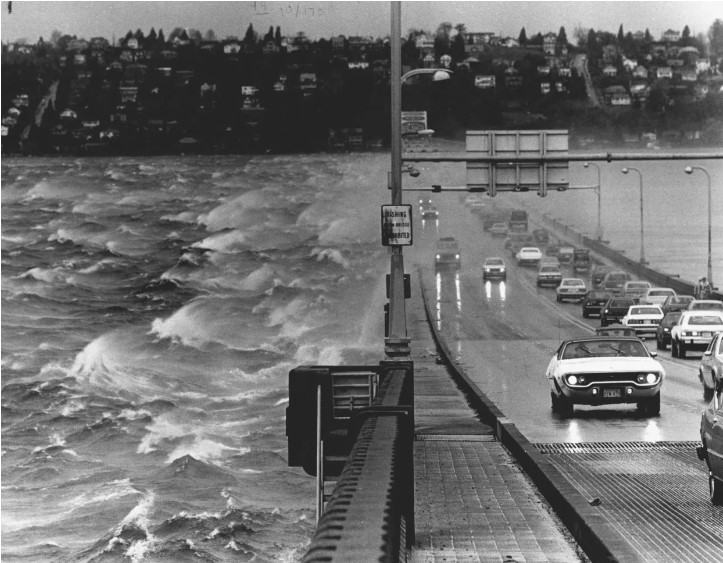
Plans for a bridge across the Narrows began as early as 1889, when the Northern Pacific Railway proposed building a trestle across the strait. Ironically, the best location for a bridge is usually the one that has the most extreme environmental conditions. The Narrows is the shortest crossing across Puget Sound, but it also has the most severe winds and the strongest currents. Any serious talk of a bridge would not start until the mid-1920’s.
The Tacoma Chamber of Commerce began to campaign for a bridge around this time, even consulting with the premier bridge builders of the time – Joseph Strauss and David Steinman. Strauss would go on to design the Golden Gate Bridge and Steinman the Mackinac Bridge. Strauss would spend much of this period campaigning to get Golden Gate off the ground, while Steinman was intimately involved with the project until 1931. The Chamber ultimately fired him for not working hard enough on securing funding. In an interesting twist, Steinman would predict the bridge’s demise during a meeting of the American Society of Civil Engineers in 1938.
The Washington Toll Bridge Authority was created in 1937 by an act of the Washington State Legislature, which appropriated money to study a bridge. Locating revenue for the bridge was a problem. Tolls alone would not cover construction costs and the ferry that operated across the strait was to have been bought out. Still, work progressed with support from the Navy, Army and the Puget Sound Naval Shipyard.
The initial design by Clark Eldridge called for a 5,000 foot long bridge with a 2,800 foot main span and 425 foot tall towers. Eldridge’s design also called for 25 foot deep stiffening trusses. State Highways sought federal support for the project and requested $11 million from the Public Works Administration (PWA).
Eldridge’s design came under attack during PWA review by what Eldridge derisively called “Eastern consulting engineers.” These were Leon Moisseiff and Frederick Lienhard, New York engineers that had just published a paper on elastic distribution. This extended Josef Milan’s deflection theory to horizontal bending under static wind load. In their paper, Moisseiff and Lienhard showed that one half of the lateral load from static wind pressure would be carried by the main cables and transmitted to the towers. Thus, large (and unsightly) stiffening trusses as proposed by Eldridge would be unnecessary.
Layout of the bridge as modified by Moisseiff
As a result, Moisseiff proposed slimming down the bridge by using 8 foot deep steel edge girders to support the roadway. This shaved $3 million from the cost of the bridge. PWA opted for the cheaper design, granting the project $6 million with an additional $1.6 million coming from tolls.
Bridge construction began on September 27, 1938 and took only 19 months to construct. At the time that it opened on July 1, 1940, it was the third longest suspension bridge in the world after George Washington in New York and Golden Gate.
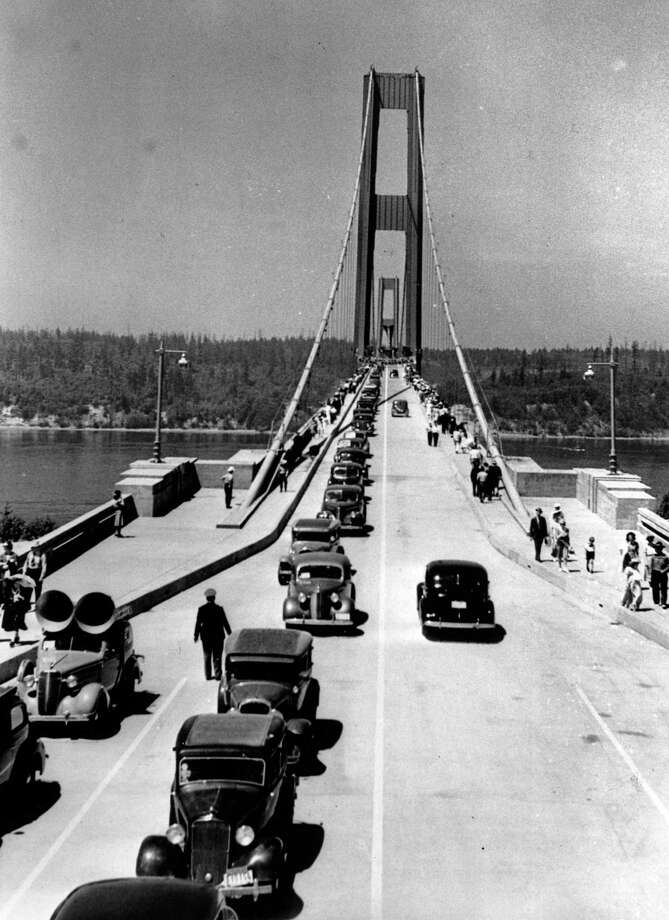
The bridge was quite narrow, only 39 feet wide with two traffic lanes. This meant its width to span ratio was an astonishing 72, compared to the previous record holder (Golden Gate) at 35. Moisseiff and Lienhard may have been correct about the transfer of lateral loading to the towers via the main cables, but what they neglected to consider was the stiffness of the bridge in the vertical direction.
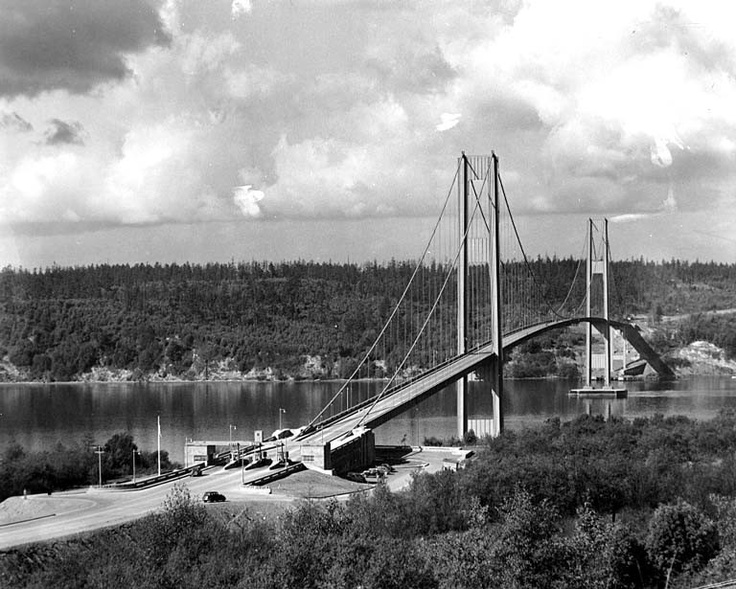
Even before it was completed, workers noted how flexible the bridge was. They dubbed the bridge “Galloping Gertie,” a nickname that eventually stuck with the public after it opened. Even in mild to moderate winds, the lack of rigidity in the superstructure would cause the deck to rise and fall by several feet in a period of 4 to 5 seconds. These oscillations became troublesome to the Toll Bridge Authority and they brought on Professor Frederick B. Farquharson from the University of Washington to study them and suggest ways to bring them down to manageable levels.
Prior to opening, cables were attached to the girders and anchored to 50 ton weights on shore. The cables broke shortly after installation.
A pair of cable stays connected the main cables to the deck and midspan. These remained in effect until the collapse, but proved ineffective.
Hydraulic dampers were installed between the towers and the floorsystem, but were damaged by sandblasting prior to painting.
Farquharson began to study the oscillation problem. He built a 1:200 scale model of the bridge for wind tunnel testing and a 1:20 scale model of the deck. His initial investigations concluded on November 2, 1940. He proposed two solutions for consideration. First, drilling holes through the girder webs and deck to allow air to circulate, thus reducing lift forces that were believed to be causing the oscillations. Second, to use a more aerodynamic shape on the outer fascia of the girders by means of deflectors or fairings to streamline the superstructure.

Although both solutions proved favorable during wind tunnel testing on the models, in practice they were still untested theories. Drilling of holes was not favored because it could not be reversed, therefore the second option was favored for implementation.
On the morning of November 7, 1940, winds clocked at 42 miles per hour were ripping through the Narrows. Such winds would be classified as a ‘minor’ windstorm, according to the Office of the Washington State Climatologist today. The bridge’s movements, considered like a carnival experience up that point, began to increase alarmingly.
Professor Farquharson drove to the bridge as quickly as he could. The film footage of the bridge motions were shot by Farquharson himself. News photographers on site also caught dramatic stills of the bridge, some of them iconic.
News Tribune Editor Leonard Coatsworth became the last person on the bridge. Coatsworth had been on his way back to his daughter’s to return her black Cocker Spaniel Tubby. Coatsworth and Tubby never made it to midspan when the bridge movements became alarming.
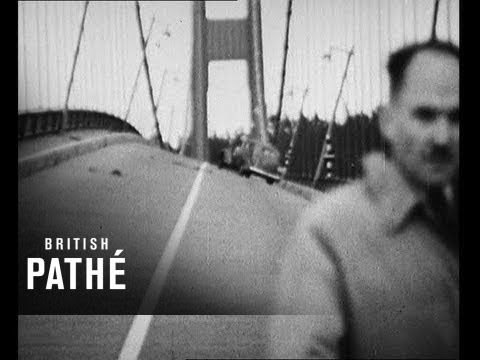
Coatsworth described in his own words what happened next, “Around me I could hear concrete cracking. I started back to the car to get the dog, but was thrown before I could reach it. The car itself began to slide from side to side on the roadway. I decided the bridge was breaking up and my only hope was to get back to shore. On hands and knees most of the time, I crawled 500 yards or more to the towers.
“My breath was coming in gasps; my knees were raw and bleeding, my hands bruised and swollen from gripping the concrete curb. Towards the last, I risked rising to my feet and running a few yards at a time. Safely back at the toll plaza, I saw the bridge in its final collapse and saw my car plunge into the Narrows.”
During one lull in the wind, Farquharson and a photographer attempted to rescue Tubby from the car. The dog was too terrified to leave the car and even bit one of the men as they tried to help. Sadly, the car and the unfortunate animal became the only casualties of the bridge collapse. Neither the car nor Tubby’s body were ever recovered. Coatsworth received $450 for the loss of his car and $364.40 in reimbursement for the contents of the car, including Tubby.
One of the insurance policies covering the bridge was unable to be collected because Merchant’s Fire Assurance Company’s insurance agent Hallett R. French had pocketed the insurance premiums. French was tried for grand larceny for withholding premiums for $800,000 of insurance. Fortunately there were many other policies covering the bridge which were able to be collected, covering about 80% of the bridge’s estimated value.
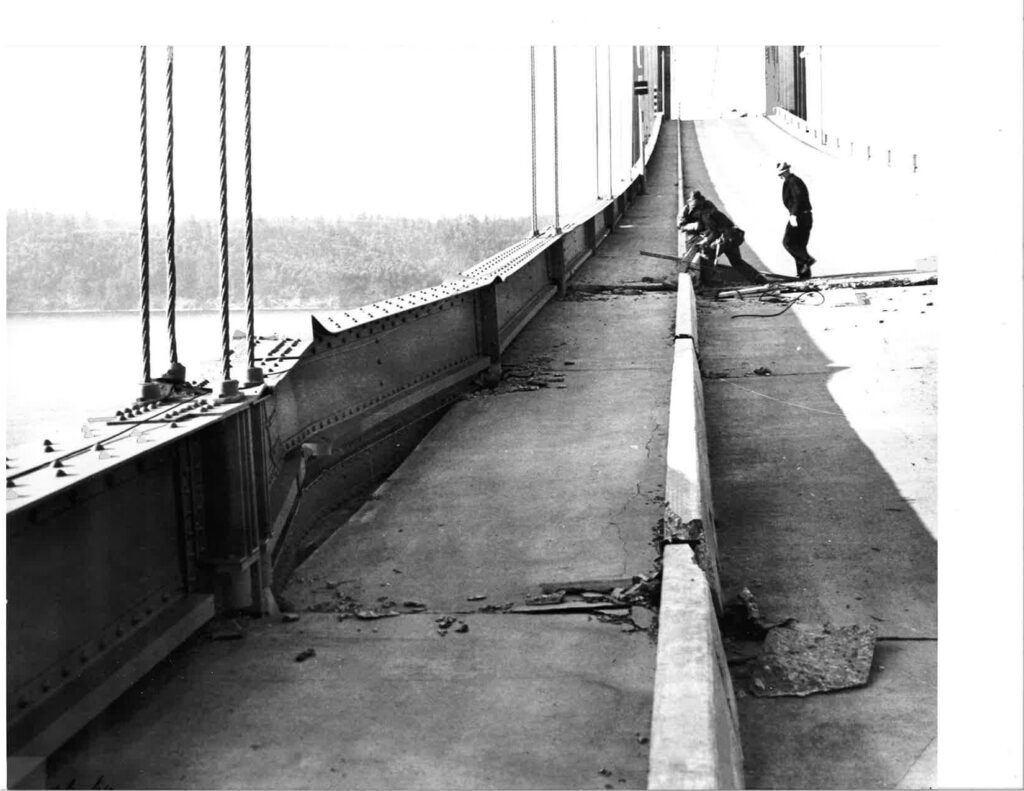
The bridge remnants were located at the bottom of the Narrows in about 180 feet of water by the Navy’s Hydrographic Office on November 28, 1940. The debris remains a permanent artificial reef. Efforts to salvage the debris continued until May 1943. Two review boards concluded that repair of the bridge was impossible and what remained of the bridge was sold as scrap for the war effort. The salvage operation cost the State more than was returned for the sale of the scrap material, with a net loss estimated at $350,000.
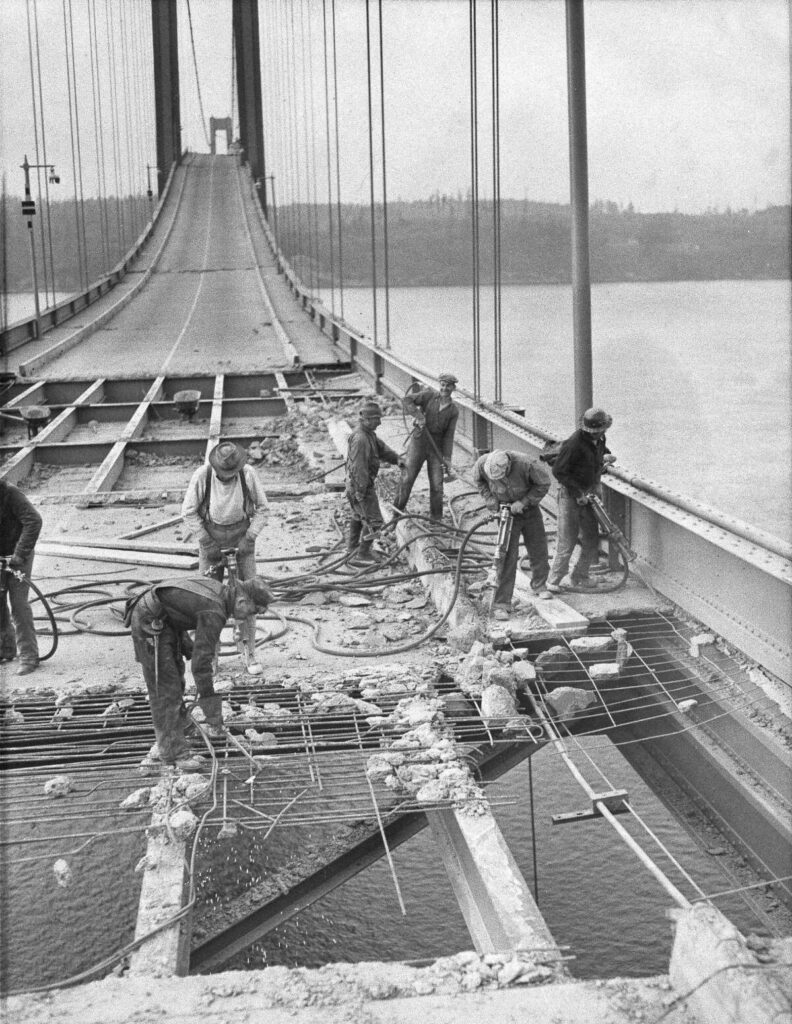
The towers in particular were heavily damaged after the main span collapsed. Without the load from the main span on the main cables, the tension in the main cables actually deflected the steel towers towards shore by some 12 feet. This permanently and irreversibly damaged the towers, rendering them unusable and they were eventually sold for scrap along with the rest of the bridge.
In addition to Farquharson’s film of the collapse, Barney Elliott and Harbine Monroe each shot separate footage from the Tacoma side. Elliott and Monroe owned The Camera Shop in Tacoma. Shot in 16mm Kodachrome, the film was duplicated for black and white newsreel and thus most video available of the collapse is seen in black and white. Arthur Leach also shot film from the west side of the bridge. Leach is believed to be the last person to actually cross the bridge before it collapsed. His film also survives with his commentary of the collapse.
The Federal Works Agency formed a commission to study the causes of the collapse. Though they drew no definitive conclusions, they explored three possible causes. The work of Professor Farquharson prior to the collapse and the input of aerodynamicist Theodore von Karmen and suspension bridge designer Othmar Ammann during the inquiry have contributed greatly to our understanding of cable supported bridge behavior. The three causes that were studied were – aerodynamic instability, eddy formations of a periodic nature and the random effects of turbulence.
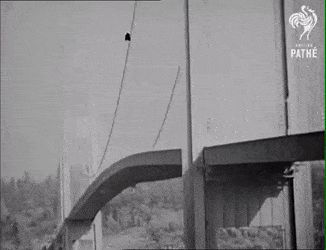
Work done since the collapse now places the blame for the collapse on a phenomenon known as aeroelastic flutter. In simple terms, flutter occurs when a structure begins to experience harmonic motion – oscillations that continue indefinitely until collapse occurs.
A structure usually has a natural tendency to positively dampen harmonic motion – that is to reduce any oscillations. When aerodynamic forces – a blowing wind – act on a structure, they can tend to negatively dampen harmonic motion. Flutter occurs when any positive damping from the structure is negated by the negative damping from external forces. The net damping becomes zero and nothing can stop the oscillations.
Cable supported bridges today are wind tunnel tested and designed to ensure that aeroelastic flutter cannot occur. Aerodynamics is an essential part of these bridge’s design, especially as we stretch what is possible. Fairings are often used to reduce the negative damping effects of aerodynamic forces, whereas torsionally rigid box girders or stiffening trusses are used to increase the positive damping effects of the structure. By balancing these effects, aeroelastic flutter can be eliminated.
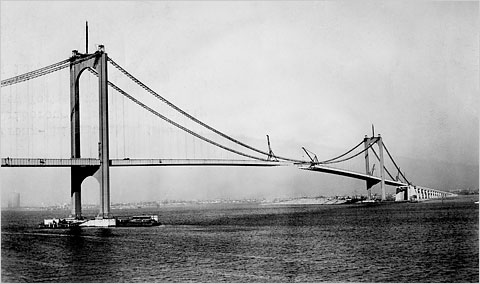
As an example of how the field continues to improve in the wake of the collapse, consider the Bronx-Whitestone Bridge. The bridge was stiffened in 1943 with 14 foot trusses to help weigh down and stiffen the superstructure and reduce oscillation. In 2003, the trusses were removed and fairings were installed – proving Professor Farquharson’s remedy may have saved the Narrows bridge.
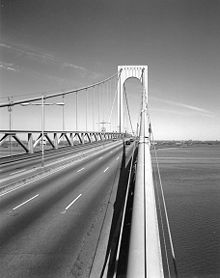
It’s Disaster November here at TheBridgeGuy! In the next edition, we’ll looked at the second Tacoma Narrows Bridge – what the designers did to prevent a repeat of the 1940 debacle, how it is fairing at 72 and what the future holds for the bridge.
Views: 1564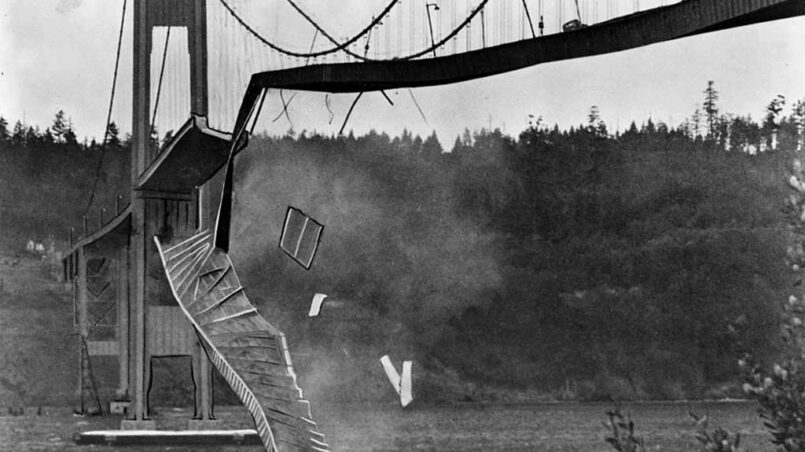
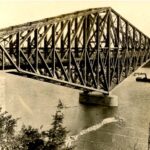
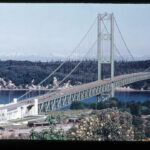
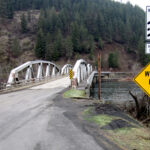
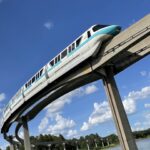

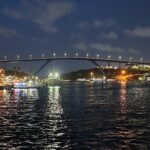
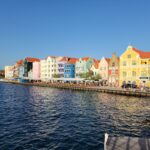
What’s up, I read your blogs on a regular basis. Your
humoristic style is awesome, keep up the good work!